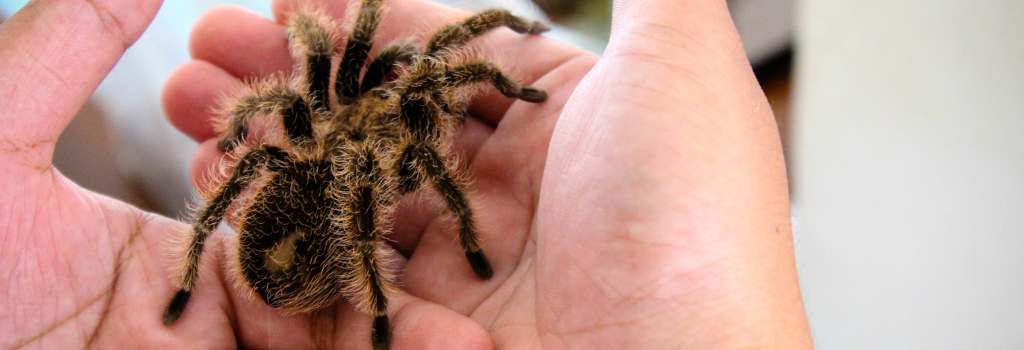For most people, spotting a tarantula can be a startling – and gross – experience. But for those who see them near their pets, things can be even more stressful. Tarantulas are pretty misunderstood creatures. With their large size, hairy bodies, and slow, creeping movements, tarantulas often look more dangerous than they really are, which has led to plenty of misconceptions about the risks they pose. The truth is, tarantulas are generally shy and far less threatening to pets than their appearance suggests. In this blog, we’ll clear up the confusion by exploring whether tarantulas are actually dangerous to dogs and cats, what can happen if your pet has a close encounter with one, and how your veterinarian can step in if care is needed.
Tarantulas & Your Pets in Southern California
Two species of tarantulas – the Mojave Blonde tarantula and the California ebony tarantula – call Southern California home and can commonly be seen throughout their mating season, which lasts from August until December. Tarantulas are more likely to be seen during these months, as they are traveling miles, actively searching for mates, and straying from their typical burrow-dwelling lifestyle. This wandering behavior is why you might notice tarantulas crossing hiking trails, sidewalks, or even appearing in your backyard in the latter half of the year.
Sightings of tarantulas are most common during dusk and nighttime hours, meaning that evening walks or late hikes are when you and your dog are most likely to run into one. They move slowly and are not aggressive by nature, but a curious pet may be tempted to paw at, sniff, or even try to catch them, which can lead to irritation from their defensive hairs or, in rare cases, a bite.
Are Tarantulas Dangerous to Dogs and Cats?
The good news for pet owners is that tarantulas aren’t particularly dangerous to dogs and cats. They may look threatening and pretty scary due to their size, but their venom is actually mild, and their bites aren’t considered life-threatening for pets – mostly just uncomfortable. Tarantulas are also pretty shy creatures, and don’t use biting as their first line of defense against predators, making cat and dog tarantula bites actually pretty rare.
The only real danger tarantulas pose to pets comes from the defensive hairs on their bodies that can get into a dog or cat’s eyes, mouth, skin, or nose, causing irritation. Thankfully, these hairs usually only cause mild discomfort for most pets. Other parts of the tarantula, like the fangs, can also give our pets some trouble, but not in the way you might think. While we already discussed that tarantula bites in dogs and cats aren’t too much of a cause for concern, the fangs and other parts of the spider can be very irritating if our pets choose to bite and chew on the tarantula instead. This is especially true for cats who enjoy batting at and chewing their prey. When these sharp parts of the tarantula’s body are repeatedly introduced to the softer, more delicate flesh in an animal’s mouth, abrasions and irritation are very likely.
Tarantula Bite vs. Urticating Hair Irritation in Pets
Being able to distinguish between when your pet has been bitten by a tarantula and when they’re experiencing irritation from urticating hairs can go a long way in getting them the medical attention and pain relief they need. There will be a few signs that can help you figure out which you’re dealing with when inspecting your pet after they’ve encountered a tarantula.

Signs of a Tarantula Bite
- Localized swelling at a paw, lip, or nose where contact happened
- Tenderness or pain (your pet may lick, paw, or avoid using the affected area)
- Mild redness at the bite site
- Occasionally a small puncture mark (though it can be hard to spot through fur)
Signs of Urticating Hair Exposure
When exposed to a tarantula’s defensive hairs, the type of irritation each pet will experience can depend on how many hairs the pet was exposed to, as well as where on their body the hairs are affected. Some common signs of urticating hair exposure include:
- Eye irritation: Redness, squinting, pawing at eyes, excessive tearing
- Nasal irritation: Sneezing, snorting, pawing at the face
- Mouth and throat irritation: Drooling, gagging, coughing, or pawing at the mouth
- Skin and body irritation: Widespread itching or rash if hairs got into the skin or fur
What Happens if My Dog or Cat Eats a Tarantula?
Dogs and cats are known for giving into their hunting instincts on occasion and eating small bugs or animals that they find outside – and even though tarantulas are usually larger in size, that doesn’t stop some of our furry friends from hunting and eating them.
If your pet is known for eating any creature in sight while on walks or hikes, the good news is that tarantulas are not highly toxic if eaten. Most of the time, ingesting a tarantula won’t cause any life-threatening issues for your pet. The only complication that a pet will experience after eating a tarantula links back to those pesky urticating hairs that can get stuck in a dog or cat’s mouth and throat and cause redness, swelling, and general irritation and discomfort. After your pet eats a tarantula – or at the very least has one in their mouth – they’ll likely experience drooling, pawing at the mouth, gagging, or temporary difficulty swallowing. If parts of the tarantula were actually ingested, these hairs can also cause more direct irritation in the stomach and digestive tract, leading to vomiting, loss of appetite, or mild stomach upset. In most cases, symptoms will improve on their own, but if you notice your pet is in extreme pain or is behaving strangely, a visit to the vet is in order.

What Your Vet Can Do to Help After a Run-In With a Tarantula
If your pet has been bitten, stung, or scratched by any spider, insect, or wild animal, it’s always a good idea to take them for a trip to the veterinarian for evaluation and treatment, even if their injuries or symptoms seem mild.
A vet can provide pain relief and properly clean and treat the bite area to reduce swelling and infection risk. If your pet is affected by urticating hairs, the vet can flush their eyes, mouth, or nasal passages to ease irritation.
To keep your pet as comfortable as possible and mitigate swelling or irritation, your veterinarian may prescribe anti-inflammatory medication or pain relief as needed. They will also monitor your pet for any serious reactions and offer supportive care to ensure that your pet’s symptoms don’t worsen or become more serious, as can happen in cases of allergic reactions to stings and bites.
If you’re concerned about your pet encountering a tarantula, keeping them on a leash while on walks and hikes, discouraging hunting outside during tarantula mating season, and being vigilant can do a lot to prevent any mishaps.
If you have questions and you'd like to reach out to us, you can call us directly at (760) 456-9556, or you can email us at [email protected]. Don't forget to follow us on social media Facebook, Instagram.

